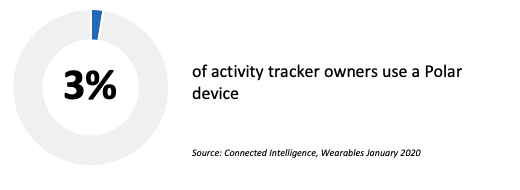
40 hour runs
Polar has launched a new multisport watch – the Grit X – that promises up to 40 hours of battery life with all of its features running. While there are many watches promising similar battery life (or more), none of them offer that level of endurance with GPS running. And without GPS, the watch is supposed to go for 100 hours between charges. The watch is priced at $430, which is similar to comparable connected sports watches and comes with the usual array of features such as compass. Altimeter, heart rate and US military-grade tests for humidity, temperature and so on.
The NPD Take:
- Although Polar was an early entrant into the activity tracker market, the brand does not enjoy strong adoption in the US market. According to the Wearables survey, the brand is owned by just 2.6% of activity tracker/connected watch owners. As such, this is the brand’s attempt to regain market share.
- The battery life is exceptional for this category and means that the owners will not need to worry about charging during a weekend away hoking or otherwise exercising. Of course, unless you are out camping, that’s more of a convenience factor rather than an essential requirement.
Happy Birthday Apple
We have just passed the five-year anniversary of the Apple Watch and one of the device’s designers, Imran Chaudhri, took the opportunity to share some Watch design trivia on Twitter, such as a photo of the design team on launch day and original sketch designs for the home screen. It’s been quite a ride for the Watch: when it launched it was met with rave reviews and unrealistic growth predictions from industry pundits, setting it up to initially be judged as less than successful. But over the past five years it has become the de facto smartwatch, essentially mirroring Apple success in the smartphone market.
The NPD Take:
- We estimate that Apple enjoys a 46 percent of the smartwatch category in the U.S. with plenty of room to grow as the product continues to add more features to broaden its appeal.
- In fairness, the competition has been slow to respond in the main. While Samsung comes closest, it has less than half the base of Apple. Beyond that, we’re into single digit ownership share for most brands.
Wearing wearables
MIT has developed a new lightweight sensor that can be woven into flexible fabrics such as athletic wear, to monitor body temperature, heart rate and so on. The sensors are – naturally – machine washable and can be integrated into clothes that look like standard apparel.
The NPD Take:
- We’ve said it before; we’ll say it again. In this time of COVID-19, and it’s potential to come back in several waves in the future, any wearable that can help track the health of consumers has significant potential. We expect that wearables will, more than ever before, pivot from being an exercise and notification device to one that is healthcare first. That means a far broader audience, such as more elderly users.
- While not the first attempt at clothing-based wearables, this latest iteration has the promise of being more naturally integrated into every day clothing, rather than specialist sportswear. Always on health monitoring


